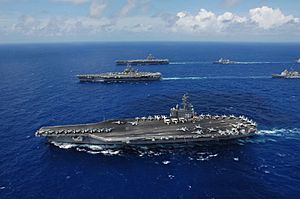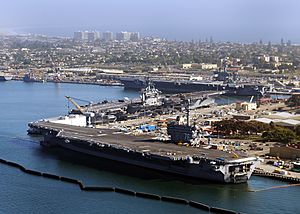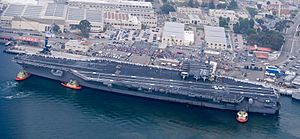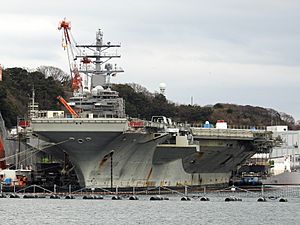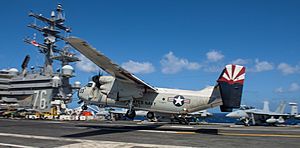USS Ronald Reagan facts for kids
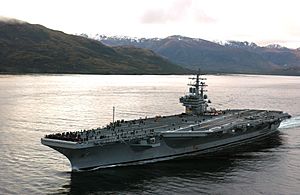
USS Ronald Reagan in the Straits of Magellan in 2004
|
|
| History | |
|---|---|
| Name | Ronald Reagan |
| Namesake | Ronald Reagan |
| Ordered | 8 December 1994 |
| Builder | Northrop Grumman Newport News |
| Laid down | 12 February 1998 |
| Launched | 4 March 2001 |
| Sponsored by | Nancy Reagan |
| Commissioned | 12 July 2003 |
| Homeport | Yokosuka |
| Identification | |
| Motto | Peace Through Strength |
| Nickname(s) | Gipper |
| Status | in active service |
| Badge | 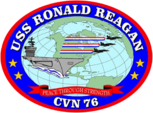 |
| General characteristics | |
| Class and type |
|
| Displacement | 101,400 long tons (113,600 short tons) |
| Length |
|
| Beam |
|
| Draft |
|
| Propulsion |
|
| Speed | 30+ knots (56+ km/h; 35+ mph) |
| Range | Unlimited distance; 20–25 years |
| Complement |
|
| Sensors and processing systems |
|
| Electronic warfare & decoys |
|
| Armament |
|
| Armor | Unknown |
| Aircraft carried | 90 fixed wing and helicopters |
The USS Ronald Reagan (CVN-76) is a huge, nuclear-powered supercarrier that serves the United States Navy. It's the ninth ship of its kind, named after Ronald Reagan, who was the President of the United States from 1981 to 1989. This amazing ship was built in Newport News, Virginia, and officially joined the Navy on July 12, 2003.
The Ronald Reagan has sailed on many missions to the Pacific Ocean and the Middle East. From 2006 to 2011, it was based in Naval Air Station North Island. In 2015, the Ronald Reagan took over from another carrier, the USS George Washington, as the main ship for Carrier Strike Group 5. This group is based in Yokosuka, Japan, and is part of the United States Seventh Fleet. Every summer since 2016, the Ronald Reagan goes on short patrols in the Western Pacific.
Contents
- Building a Giant Ship
- Adventures at Sea
- First Big Mission: 2006
- Quick Mission: 2007
- Helping Others: 2008 Mission
- 2009 Mission
- Maintenance and Help: 2010
- Helping Japan: 2011 Mission
- Moving Home: 2012 and 2013
- New Home in Japan: 2014 and 2015
- 2016 Patrol
- Busy Year: 2017
- 2018 Patrols
- 2019 Patrol
- 2020 and 2021 Missions
- 2022 Patrols
- Future Plans: 2023
- Images for kids
- More to Explore
Building a Giant Ship
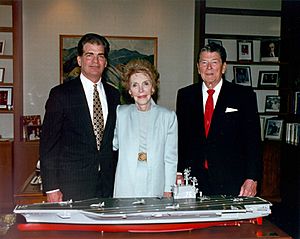
The Navy decided to build the Ronald Reagan on December 8, 1994. Its construction officially began on February 12, 1998, when its keel (the main bottom part of the ship) was laid down. Building the ship cost about $4.5 billion.
The ship was named by Ronald Reagan's wife, Nancy Reagan, on March 4, 2001. The crew moved onto the ship in October 2002. The Ronald Reagan was officially put into service on July 12, 2003, at Naval Station Norfolk.
At the ceremony, Vice President Dick Cheney and Nancy Reagan were there. Nancy Reagan gave the crew their first order: "Man the ship and bring her to life." The Ronald Reagan began its first journey on July 21, 2003. President Reagan, who was ill, passed away 11 months later.
Why the Name Ronald Reagan?
The Ronald Reagan is special because it was the first aircraft carrier and the first nuclear-powered warship ever named after a living former president. Unlike many people honored this way, Ronald Reagan wasn't a Navy officer. However, he was the Commander-in-Chief of the military, and he had a plan to build a "600-ship Navy."
The Ship's Special Seal
The Ronald Reagan's seal, or emblem, was created by its first crew members. It has a red border, like the special china used by the Reagans in the White House. Four gold stars on the seal show that Reagan was the 40th US President. They also stand for his four ideas of freedom: personal freedom, money-making chances, worldwide democracy, and national pride. The ship's motto, "Peace through Strength," was a big idea for Reagan.
The seal shows the aircraft carrier on the West Coast, because Reagan was the governor of California for two terms, and the ship's home is in the Pacific. Three airplanes with patriotic trails represent three big military actions during Reagan's time as president. The globe shows Reagan's idea of worldwide democracy, with the United States in the middle, showing national pride. The colors red, white, and blue are used a lot, just like the American flag.
Adventures at Sea
On May 8, 2004, the Ronald Reagan was ready for all flight operations. It then sailed from Virginia, through the Strait of Magellan, to its new home in Naval Air Station North Island, San Diego.
The ship visited Rio de Janeiro, Brazil, on June 5, 2004. While there, former President Reagan passed away. The ship held a ceremony to honor him. After leaving Rio, the Ronald Reagan sailed through the Strait of Magellan and visited Valparaíso, Chile, and Callao, Peru, before arriving in San Diego on July 23, 2004.
First Big Mission: 2006
The Ronald Reagan left San Diego on January 4, 2006, for its first major mission. It supported military operations in the Persian Gulf. On January 28, 2006, an F/A-18 Hornet jet crashed on the ship's flight deck near Brisbane, Australia. The pilot was safe, but the plane was lost. The ship returned home on July 6, 2006.
Quick Mission: 2007
The Ronald Reagan went on an unexpected mission to the Western Pacific on January 27, 2007. This was part of the Navy's plan to quickly send ships where they are needed. The ship returned to San Diego on April 20, 2007.
In January 2007, the Ronald Reagan won a special award called the "Battle Efficiency E" for being the best carrier on the West Coast. This was the first time the ship had won this award.
On December 15, 2007, the carrier helped a cruise ship off the coast of Baja California. A helicopter flew a teenager with a burst appendix to the Ronald Reagan, where the ship's doctor performed emergency surgery.
Helping Others: 2008 Mission
The Ronald Reagan left San Diego on May 19, 2008, for a planned mission. The ship's group helped with disaster relief in the Philippines on June 24, 2008. Typhoon Fengshen had caused a lot of damage and killed many people. The Ronald Reagan's helicopters delivered over 519,000 pounds of food, water, and other supplies to areas that couldn't be reached by trucks. This mission earned the entire group a special medal for humanitarian service.
The ship then went to the U.S. Fifth Fleet area and launched over 1,150 flights to support military operations in Afghanistan. The Ronald Reagan returned to San Diego on November 25, 2008.
In February 2009, the Ronald Reagan won its second "Battle Efficiency Award."
2009 Mission
On May 28, 2009, the Ronald Reagan went on another mission. It launched its first flights to support operations on July 6. The ship returned home on October 21 after a five-month mission.
Maintenance and Help: 2010
In early 2010, the Ronald Reagan won two more awards: the "Safety S" Award and its third "Battle E" award in four years.
On May 19, 2010, the Ronald Reagan finished a six-month maintenance period. During this time, the ship received new technology for its combat systems and firefighting equipment. Its living spaces were also improved. This project was a big team effort involving several Navy shipyards.
On May 18, 2010, the Ronald Reagan went out for sea trials to check if everything was working correctly. It returned on May 19, marking the end of its maintenance.
In November 2010, the ship helped passengers on the cruise ship Carnival Splendor, which had lost power due to an engine fire in the Pacific Ocean. The Ronald Reagan provided emergency supplies.
Helping Japan: 2011 Mission
The ship left for a mission in Asia on February 2, 2011. On March 11, 2011, the Ronald Reagan was near Korea for an exercise, but it was quickly sent to Japan to help after a huge earthquake and tsunami. The ship, located off Sendai, became a refueling station for Japanese helicopters helping with relief. US Navy helicopters also flew missions from the carrier.
On March 14, 2011, the ship had to move to avoid a radioactive cloud from the Fukushima I nuclear accidents. On March 23, the crew cleaned the ship to remove any possible radiation. On April 4, 2011, Japan's defense minister visited the ship to thank the crew for their help. He said, "I have never been more encouraged by and proud of the fact that the United States is our ally." The ship returned to San Diego on September 8, 2011.
Moving Home: 2012 and 2013
On January 10, 2012, the Ronald Reagan's homeport was changed to Bremerton, Washington, for over a year for repairs. To save money, the Navy transported many sailors' cars on the ship's deck. The ship returned to San Diego on March 21, 2013.
New Home in Japan: 2014 and 2015
In 2014, the Navy announced that the Ronald Reagan would replace the USS George Washington as the main carrier based in Yokosuka, Japan, starting in 2015.
In August 2015, the Ronald Reagan and George Washington docked together in San Diego. The crews of both carriers switched ships. This meant fewer sailors had to move between San Diego and Japan. The Ronald Reagan became the main ship for Carrier Strike Group 5. On October 1, 2015, it arrived at its new homeport in Yokosuka, Japan.
The Ronald Reagan left for its yearly patrol of the Western Pacific on October 15. It conducted exercises with the Japan Maritime Self-Defense Force and the Republic of Korea Navy. The Prime Minister of Japan, Shinzo Abe, even visited the ship. The ship returned to Yokosuka on December 3.
2016 Patrol
On June 4, 2016, the Ronald Reagan sailed to the South China Sea. It returned after 53 days for a short break and inspections. The ship temporarily left port to avoid Typhoon Lionrock. After inspections, it went back to sea on September 3. The ship then took part in military exercises before returning to Yokosuka on November 21.
Busy Year: 2017
Starting January 10, the ship began a period of maintenance to upgrade parts of the ship, including the flight deck and living spaces. On April 19, Vice President Mike Pence visited the ship. On May 16, the Ronald Reagan left for its yearly mission to relieve another carrier that was near North Korea due to political tensions.
It visited Singapore in June and then Australia, where it participated in Exercise Talisman Saber with Australian and other forces in July. It then visited Brisbane before returning to Japan on August 9. On September 8, it left Yokosuka again to patrol near Korea after North Korea launched a missile and conducted a nuclear test. On October 2, the ship visited Hong Kong.
In November, the Ronald Reagan conducted drills with two other US aircraft carriers, the USS Nimitz and the USS Theodore Roosevelt. This was the first time in ten years that three US carrier groups worked together in Asia. They were also joined by Japanese and South Korean warships. These drills happened during US President Donald Trump's visit to Asia.
On November 22, a C-2A Greyhound cargo plane with 11 people on board crashed into the Philippine Sea while flying to the carrier. Eight of the 11 people were rescued. The Ronald Reagan returned to Yokosuka on December 4.
2018 Patrols
On May 28, 2018, the Ronald Reagan left for its regular patrol of the Pacific. Its departure was a few weeks late due to repairs. After patrolling the South China Sea, the ship visited the Philippines for the first time.
From June 7 to 16, the carrier participated in the Malabar 2018 exercise with Japan and India near Guam. The Ronald Reagan returned to Yokosuka on July 24. It left port twice in July and August to avoid typhoons. On August 31, 2018, the carrier trained with the Japanese helicopter destroyer Kaga.
On November 21, 2018, the ship visited Hong Kong.
2019 Patrol
On August 24, 2019, the Ronald Reagan returned to Yokosuka Naval Base after a short patrol. The ship made two stops: first in Brisbane for a military exercise, then in Manila. Between these stops, it sailed through the South China Sea to show that the seas should be free for all ships. The ship also took part in several exercises with partner nations, including Japan.
2020 and 2021 Missions
In 2020, some cases of the coronavirus were reported on the Ronald Reagan. This led to the naval base outside Tokyo being closed for a short time.
On July 5, 2020, the Ronald Reagan Carrier Strike Group went to the South China Sea along with another carrier, the USS Nimitz.
On June 26, 2021, the Ronald Reagan was sent to the Middle East to help with the withdrawal of US troops from Afghanistan.
2022 Patrols
In May 2022, the Ronald Reagan was relieved by the USS Abraham Lincoln in Japan and then led its Carrier Strike Group into the Philippine Sea.
The Ronald Reagan left Singapore on July 23 to sail through the South China Sea. On August 4, 2022, the ship was ordered to stay near Taiwan after China launched missiles. This was in response to Speaker of the United States House of Representatives Nancy Pelosi's visit to Taiwan. On August 19, 2022, the Ronald Reagan returned to its home port in Yokosuka, Japan.
On September 12, 2022, the Ronald Reagan left Yokosuka for the second part of its patrol. It arrived in Busan, South Korea, on September 23, 2022. This was the first time in four years that a US Navy aircraft carrier had visited South Korea.
Future Plans: 2023
In April 2023, the Navy announced that the USS George Washington will return to Yokosuka, Japan, in 2024 to take over from the Ronald Reagan. The Ronald Reagan will then move to Bremerton, Washington, for a planned maintenance period in a drydock. On June 25, 2023, the Ronald Reagan and two escort ships visited Da Nang, Vietnam, staying until June 30. This was the third time a US carrier had visited Vietnam since 2018.
Images for kids
-
Former First Lady Nancy Reagan christens Ronald Reagan with President George W. Bush and former Newport News Shipbuilding CEO William Fricks looking on, 4 March 2001.
-
Ronald Reagan is aided by harbor tugs as she enters Pearl Harbor, Hawaii, for a port visit on 28 June 2006.
-
Sailors aboard Ronald Reagan man the rails as the supercarrier arrives at her new homeport in San Diego, California, on 23 July 2004.
More to Explore
 In Spanish: USS Ronald Reagan (CVN-76) para niños
In Spanish: USS Ronald Reagan (CVN-76) para niños
- Carrier-based aircraft
- Carrier Strike Group 5
- List of aircraft carriers of the United States Navy
- Modern United States Navy carrier air operations
- Naval aviator (United States)


